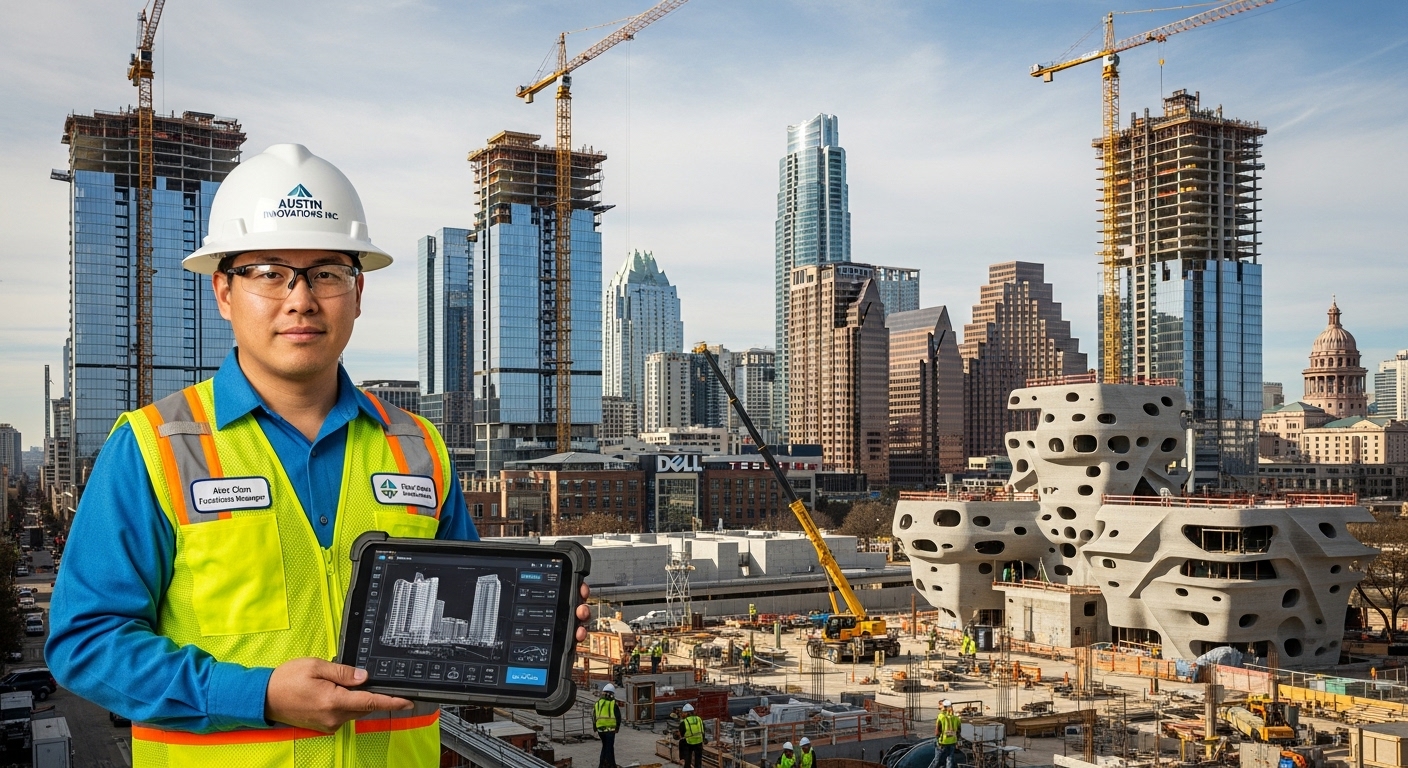Based on the search results and the Austin, TX market data, I’ll create a comprehensive SEO blog post targeting facilities managers in this rapidly growing market.
Austin’s Construction Boom Creates New Opportunities for Facilities Management Excellence
Austin, Texas, is experiencing unprecedented growth that’s reshaping the facilities management landscape across Central Texas. With major projects like the world’s largest 3D-printed neighborhood in nearby Georgetown and Apple’s massive $600 billion U.S. manufacturing expansion impacting Austin directly, facilities managers are finding themselves at the center of an exciting transformation.
Austin’s Booming Construction Market Drives FM Innovation
The Austin metropolitan area is witnessing remarkable development that extends far beyond the city limits. Recent data shows multiple mega-projects creating ripple effects throughout Central Texas:
Major Infrastructure Investments Shape the Region
Technology Manufacturing Expansion: Apple’s substantial investment includes new chip production facilities in Austin and partnerships with major suppliers, creating thousands of jobs and expanding the need for sophisticated facilities management services. These high-tech environments require specialized maintenance protocols and advanced building systems management.
Revolutionary Construction Methods: Georgetown’s completion of the world’s largest 3D-printed neighborhood represents a shift toward innovative building technologies. While cost and timeline savings are still being evaluated, these concrete-printed structures offer stronger, more energy-efficient buildings that will require new maintenance approaches.
Transportation Infrastructure: The North Texas SH 199 project and other regional improvements are enhancing connectivity across Central Texas, making Austin more accessible while increasing demand for commercial and residential development.
What Austin’s Growth Means for Facilities Managers
Increased Demand for Specialized Services
The rapid expansion creates unique challenges for facilities managers responsible for ongoing property maintenance:
Technology-Intensive Environments: With companies like PEGATRON establishing their first U.S. manufacturing site in Georgetown and major tech expansions throughout the region, facilities managers need expertise in:
- Clean room maintenance protocols
- Advanced HVAC systems for manufacturing environments
- Specialized electrical and data infrastructure
- Energy management for high-consumption facilities
Mixed-Use Development Complexity: Austin’s growth pattern includes extensive mixed-use developments that require comprehensive management approaches combining:
- Commercial office space maintenance
- Retail facility standards
- Residential property management
- Shared amenity space oversight
Regulatory Compliance in a Growing Market
Texas facilities management is governed by specific state regulations that impact daily operations. The Texas Facilities Commission (TFC) oversees state property management and sets standards that often influence private sector best practices.
Key compliance areas include:
- Energy efficiency requirements for new construction
- Building automation system standards
- Sustainability reporting for large facilities
- Safety protocols for occupied spaces during renovations
Strategic Solutions for Austin’s Unique Market
Technology Integration for Efficiency
Modern facilities management in Austin requires sophisticated approaches to handle the area’s rapid growth:
Predictive Maintenance Systems: With new construction technologies and advanced building systems, preventive maintenance has evolved into predictive maintenance using IoT sensors and data analytics.
Energy Management Optimization: Austin Energy’s renewable energy initiatives and Texas’s competitive electricity market create opportunities for significant cost savings through strategic energy management.
Vendor Management Excellence: The growing market means facilities managers need robust vendor networks capable of handling diverse property types, from traditional office buildings to advanced manufacturing facilities.
Meeting the Challenge of Rapid Expansion
Austin’s construction boom presents both opportunities and challenges:
Capacity Planning: Facilities managers must anticipate growth patterns and scale services accordingly. The region’s development isn’t just in Austin proper—it extends to Georgetown, Round Rock, and throughout Central Texas.
Specialized Expertise Requirements: New construction methods and advanced building systems require ongoing education and potentially new certifications for facilities management teams.
Cost Management: While the market is growing, competition for quality vendors and skilled technicians is intensifying, making strategic partnerships more important than ever.
Building Partnerships in Austin’s Dynamic Market
Local Market Knowledge
Understanding Central Texas’s unique characteristics is crucial:
- Weather patterns affecting building maintenance cycles
- Local building codes and permit requirements
- Regional supplier networks and lead times
- Workforce availability and training needs
Future-Proofing Strategies
Successful facilities management in Austin requires forward-thinking approaches:
Sustainability Integration: With increasing focus on ESG (Environmental, Social, and Governance) requirements, facilities managers need strategies for energy efficiency, waste reduction, and sustainable operations.
Scalability Planning: As properties expand or tenant needs change, facilities management systems must adapt quickly without compromising service quality.
Technology Adoption: From building automation systems to mobile maintenance management platforms, technology integration is essential for competitive advantage.
Navigating Austin’s Competitive Advantage
The Austin market offers unique opportunities for facilities managers who understand the local landscape. With construction activity spanning from innovative 3D-printed neighborhoods to billion-dollar technology manufacturing facilities, the region demands sophisticated property management approaches.
Regional Coordination: Projects throughout Central Texas—from Austin to Fort Worth—create opportunities for facilities managers who can coordinate services across multiple properties and diverse building types.
Innovation Leadership: Austin’s reputation as a technology hub means facilities managers here often pilot new approaches that spread throughout Texas and beyond.
The combination of rapid growth, technological innovation, and diverse property types makes Austin a premier market for facilities management excellence. Success requires understanding both traditional maintenance fundamentals and emerging trends in building technology, sustainability, and operational efficiency.
Whether managing established commercial properties or overseeing cutting-edge manufacturing facilities, Austin’s facilities managers are positioned at the forefront of industry evolution. The region’s continued investment in infrastructure, technology, and sustainable development ensures that facilities management will remain a critical component of Central Texas’s success story.
By staying informed about local development patterns, regulatory changes, and industry innovations, facilities managers can capitalize on Austin’s tremendous growth while delivering exceptional results for property owners and tenants throughout this dynamic market.


0 Comments